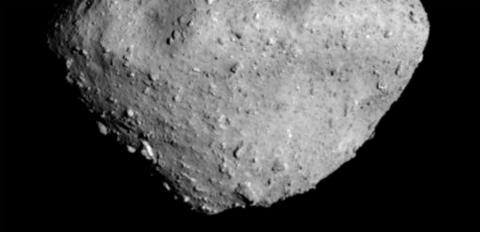#Tech#Landing On Asteroid Ryugu: Japan Finally Picks Touch Down Spot For The Hayabusa-2 Mission
Landing On Asteroid Ryugu: Japan Finally Picks Touch Down Spot For The Hayabusa-2 Mission
JAXA has finally announced where the Hayabusa-2 spacecraft, the MASCOT lander, and the three MINERVA-II rovers will be landing on the surface of asteroid Ryugu.
After much deliberation, the Japan Aerospace Exploration Agency (JAXA) has finally announced the landing spot for its highly-mediatized Hayabusa-2 mission, reports Gizmodo.
Following an all-day landing site selection conference held last week, JAXA representatives have designated the landing places for the Hayabusa-2 spacecraft, as well as the MASCOT lander and the three MINERVA-II rovers, on the surface of asteroid Ryugu.
The Hayabusa-2 spacecraft will be making its first touch-and-go landing near Ryugu’s equator, JAXA stated on August 23. Meanwhile, the MASCOT lander will be making its descent in the asteroid’s southern hemisphere, whereas the rovers will be deployed in Ryugu’s northern hemisphere.
The decision was made together with officials from the French space agency (Centre National d’Etudes Spatiales) and the German Aerospace Center (DLR), which operate the MASCOT lander.
The newly chosen landing sites will ensure that the spacecraft don’t get in the way of each other and that the Hayabusa-2 mission studies Ryugu in all its complexity.
As previously reported by the Inquisitr, the Hayabusa-1 spacecraft carrying the MASCOT lander and the three MINERVA-II rovers arrived at the 3,000-foot-wide (900 meters) space rock earlier this summer, settling into an observational point above 12 miles (nearly 20 kilometers) above the asteroid on June 27.
Launched in 2014, this is Japan’s second sample recovery mission from an asteroid, after the original Hayabusa spacecraft paid a visit to asteroid Itokawa in 2005 and brought back samples for analysis five years later, the Inquisitr recently reported.
Touch Down Of The MINERVA-II Rovers
The first to touch down on Ryugu will be the three tiny MINERVA-II rovers. Dubbed MINERVA-II-1a, MINERVA-II-1b, and MINERVA-II-2, the spacecraft will descend in a landing spot designated as N6, located in the asteroid’s northern hemisphere.
The MINERVA-II-1 rovers are slated to conduct their first operations on September 20 and 21 and will be hopping around Ryugu’s surface kicking up dust particles for sampling and analysis. The wheeless rovers carry optical and ultraviolet LEDs to light up the floating dust particles, and are also equipped with a stereo and a wide-angle camera, as well as a thermometer and accelerometer, notes the (IAU).
According to Space.com, the tiny rovers are the successors of MINERVA-I, which made history during Japan’s first asteroid-sampling mission targeting Itokawa.
Here’s Where The MASCOT Lander Will Be Deployed
Next up is the MASCOT lander, which will touch down on asteroid Ryugu on October 3. Short for Mobile Asteroid Surface Scout, the DLR-CNES operated spacecraft will land in a site known as MA-9, found in the space rock’s southern hemisphere.
This prime location has been described as “an almost perfect landing site” because it meets as series of strict requirement in term of surface temperature and features, explained the .
As reported by the Inquisitr, the surface of asteroid Ryugu is completely dotted with large boulders — something never before seen in an asteroid.
“Although scientifically very interesting, this is also a challenge for a small lander and for sampling,” said Tra-Mi Ho, MASCOT project manager at the DLR.
Fortunately, the MA-9 landing spot is less strewn with sizeable boulders, which means that the 22-pound (10 kilograms) spacecraft as a better chance at making a successful touch down in this area.
“In the vicinity of the landing site, there are numerous boulders up to 30 meters [98 feet] tall, but the really big rocks are not located in the MA-9 region,” note DLR officials.
At the same time, MA-9 boasts surface comfortable surface temperatures ranging between 47 degrees Celsius (about 116 degrees Fahrenheit) during the day and minus 63 degrees Celsius (minus 81.4 degrees Fahrenheit) at night.
But perhaps the greatest advantage of MA-9 from a scientific standpoint is that the area is compiled of fresher material, with little exposure to cosmic radiation and interplanetary dust compared to other regions on the surface of Ryugu, “and is therefore still very primordial and in an unchanged state,” notes the DLR.
Landing Site For The Hayabusa-2 Spacecraft
Last but not least, Japan’s Hayabusa-2 spacecraft will touch down on Ryugu in late October, in an area designated as L08. The Japanese orbiter will first conduct two landing rehearsals next month, on September 12, and in mid-October, and then descend in a specifically chosen spot near the asteroid’s equator. Two other nearby spots, dubbed L07 and M04, have been designated as backup landing sites.
All the three sites satisfy the ideal conditions to support the landing of Hayabusa-2, judging by the spacecraft’s optimal operating temperature, the direction of its solar panels, and length of its sampling device, notes Gizmodo.
For instance, L08, L07, and M04 have surface temperatures of less than 97 Celsius (206 Fahrenheit), are located within 200 meters (656 feet) of Ryugu’s equator and represent flat, 300-foot-wide (100 meters) regions, ideal for landing a spacecraft on the surface of the asteroid. At the same time, the boulders found in these locations are less than 50 centimeters (20 inches) high.
“We learned that that asteroid is not friendly to us, so [landing is] not as easy as we had supposed when we were planning the mission,” Masaki Fujimoto, Deputy Director General at JAXA’s Institute of Space and Astronautical Science, said in a statement.
All in all, the Hayabusa-2 orbiter will be performing three touch-and-go landings on Ryugu, blasting the asteroid with a copper projectile to dislodge and retrieve samples from below the space rock’s surface. The spacecraft will remain in Ryugu’s orbit until December 2019, during which time it will study the asteroid both from above and on a surface level. The mission will head back home at the end of next year and is expected to return the asteroid samples in December 2020.
